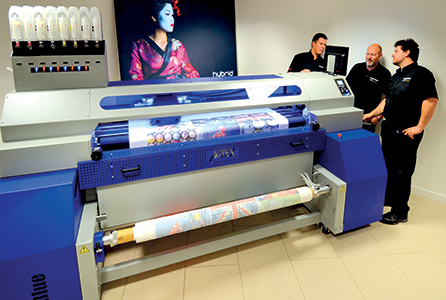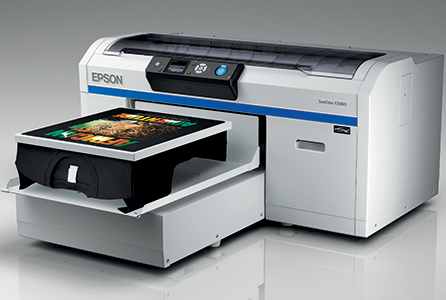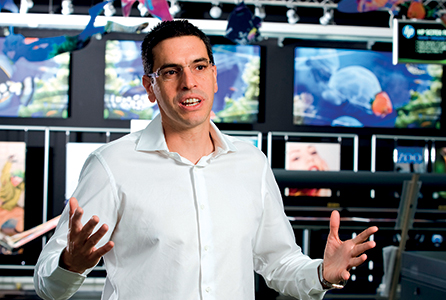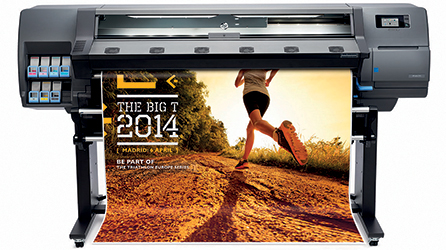
For the refurbishment of the Afryka Coffee and Tea House in Wroclaw, Poland, Integart wanted to showcase the versatility of HP Latex printing technologies, with every single decorated surface or piece of furniture created using the technology
The market for digitally printed textiles has seen massive growth over the past few years and continues to increase, providing sign-makers with a whole new range of creative options to add extra strings to their bows.
I asked three of the leading players in the field of direct to textile printing equipment to give an overview of the latest technology and the opportunities it offers to sign-makers.
As Stephen Woodall, national sales manager for textile and apparel at Mimaki’s exclusive UK and Irish distributor, Hybrid Services, observes: “The popularity and value of digitally printed textile has soared in recent years—mirrored by development and improvements in digital textile printing hard-ware, ink and materials. Together, this has created vibrant opportunities for established sign-makers to expand into textile printing and generate extra revenue.”

This has created vibrant opportunities for established sign-makers to expand into textile printing and generate extra revenue”
Woodall sees many reasons why textile printing is becoming so prominent, from branding and decorating the walkways in airports to high-end retail stores: “Textile is easy to transport as it is damage-resistant compared to other media and very light-weight, lowering delivery costs. It’s easy to install and replace and can create additional revenue, as graphics can be renewed more frequently to suit seasonal or promotional requirements,” he summarises.
‘Onesie’ wonder
The MTEX Blue, hailed as Mimaki’s new direct to polyester superstar, offers an all-in-one and easy to use option.
“The MTEX Blue direct to polyester dye-sublimation printer is based on Mimaki textile technology in an easy to use package, with an in-line fixation unit, making it an excellent transition model for sign and graphics producers to adopt,” Woodall explains, adding: “With printing and heat fixation handled as a single process, the MTEX Blue is ideal if short on space in the print room as the machine takes up a single footprint rather than having separate units for each part of the process.

The MTEX Blue direct to polyester dye-sublimation printer is based on Mimaki textile technology in an easy to use package, with an in-line fixation unit, which exclusive UK and Irish distributor Hybrid Services says makes it an excellent transition model for sign and graphics producers to adopt
“Being direct to polyester, the MTEX Blue is ideal for printing flags, soft signage and retail PoS, such as lightboxes and the results achievable are impressive. The soft finish you get with dye-sublimation adds depth and texture to graphics and really gives the wow factor.”
Confidence in this market is shared by another key player in the form of Epson, with its sales manager for ProGraphics, Phil McMullin, commenting: “With the rapid growth in demand for digital-textile-printing, sign-makers looking to enhance or expand on the print services they offer have a number of very interesting options available to them.”
He predicts: “The trend for bespoke and highly creative items, whether clothing or décor products, is set to grow significantly over the next few years and businesses with the technology in place to print designs digitally and in high quality, direct onto a range of textiles and media will have the advantage over competitors.”
McMullin expands: “There is considerable potential for print companies that get creative and print personalised and promotional items to complement their existing signage product port-folio. Items such as aprons, bags, cushions, t-shirts and clothing can be produced in large or small volume and can be run alongside current technology easily and with minimal investment, yet offer significant ROI.”
McMullin says that Epson’s SureColor SC-F2000 direct-to-textile desktop printer, featuring Epson’s PrecisionCore TFP printhead, fits into this sector perfectly. It prints onto a wide range of textiles and media up to 25mm thick, is easy to set up and use, and is fast—printing a single t-shirt in 27 seconds.

Epson’s SureColor SC-F2000 direct to textile desktop printer, with UltraChrome DG ink and Garment Creator software, make it simple to create customised designs onto a range of items
“Its UltraChrome DG ink and Garment Creator software make it simple to produce customised designs onto a range of items and offers businesses the opportunity to start making money instantly,” says McMullin.
Suited to a T
Hampshire based t-shirt printing company SixTeeSix has seen a significant increase in production and profits as a result of investing in an Epson SureColor SC-F2000 direct-to-garment printer in order to expand its service offering to print t-shirts while-you-wait.
SixTeeSix has been offering bespoke garment design and printing services since 1999. Owner Mark Rhone originally ran the online t-shirt printing business from home and opened the retail premises in January 2015, in order to have a more visible presence and to offer his customers a more personalised experience.
“The opening of the new shop was the perfect timing for us to put our plans to print direct-to-garment into action,” says Rhone, adding: “I had been looking at direct-to-garment printing for around three years and could see the benefits to my customers and my business. I evaluated several printers during that time and decided on the Epson SureColor SC-F2000 direct-to-garment printer, which is fairly new to the market. I’ve worked with Epson printers before and they have a great reputation for good quality and reliability, plus I really like the fact that the whole system—from chassis to printhead to ink—is designed and built entirely by Epson. The printer was very straightforward to install and set up and couldn’t be easier to use.”

(Above & below) Hampshire based t-shirt printing company SixTeeSix has seen a significant increase in production and profits as a result of investing in an Epson SureColor SC-F2000 direct to garment printer, with over 6,000 garments printed within the first six months after installation
Rhone is delighted with his Epson printer and printed over 6,000 garments within the first six months after installation: “I’ve had absolutely no problems with the SureColor printer and can happily print one-offs or multiple orders—for example, I fulfilled an order for 100 hoodies for local school leavers and the quality was outstanding. My retail customers like it too as they can bring in their own design or photo and have their t-shirt printed while-they wait.”
He also prints his own branded cotton tote bags on the SC-F2000, which he uses instead of carrier bags as they are reuseable and more eco-friendly than plastic bags, with the added benefit of free advertising for his business.
“The SureColor SC-F2000 has enabled me to expand my business in a number of very creative ways. Without the Epson printer I wouldn’t have the business I have today,” concludes Rhone.
Material changes
HP Graphic Solutions Business, EMEA marketing director, Ronen Zioni, sees the move to textile printing for those already using HP Latex printers as a relatively simple one, primarily being a matter of substituting textile substrates for their current PVC, vinyl, and paper.

Ronen Zioni, HP Graphic Solutions Business, EMEA marketing director, sees the move to textile printing for those already using HP Latex printers as a relatively simple one, primarily being a matter of substituting textile substrates for their current PVC, vinyl, and paper
“The diversity of materials that can be printed with HP Latex technologies is truly impressive, encompassing a large number of wall coverings—both woven and non-woven,” Zioni enthuses, adding: “These include reinforced banner materials, as well as natural and synthetic textiles specially developed to meet the demands of applications. From banners for use indoors and outdoors, flag materials that hold vibrant colours and still furl naturally when printed, to a full range of canvases to suit venues and applications, the possibilities are boundless.

The diversity of materials that can be printed with HP Latex technologies is truly impressive, encompassing a large number of wall coverings—both woven and non-woven ”
“To start with, large-format print-service-providers (PSPs) could look at simply expanding their product port-folio to include textile signage applications, such as banners and flags. However, their market is potentially much bigger if they explore the non-signage opportunities as well.”
These sectors include furnishing and interior décor applications like upholstery, window treatments, bedding, office furniture, and wall coverings. One application that hovers on the cusp of signage and interior décor is the printing of photographs and art on canvas for display in the home or office. “These are premium products that can differentiate a PSP as well as help to increase revenues,” says Zioni.
Another possibility that is a further step away from most PSPs’ normal work, but offers lucrative opportunities to develop specialist skills include the apparel, or garment, and accessories sector.
“While this sounds like an unfamiliar product offering for a PSP, a fresh look at local businesses and industries could reveal an unexpected opportunity,” urges Zioni, adding: “Apparel proofing and prototypes require quick turnaround, high quality, odourless products with vivid colours. As such, this segment is a great fit for HP Latex technology as it requires no washing or post printing fixation processes.”
‘Appy to assist
In addition, the HP Latex large-format printing mobile app enables remote monitoring of HP Latex 310, 330, and 360 printers including job information, print status and alerts. This reportedly enables PSPs to stay informed about the status of print jobs from anywhere in or out of the office, and to track projects through to completion, as well as monitor print status and supplies to avoid surprises.

The HP Latex 310 printer can be remotely monitored using the HP Latex large-format printing mobile app, which enables PSPs to stay informed about the status of print jobs whilst on the move
“PSPs have shown significant interest in the HP Latex Mobile app,” says Xavier Garcia, vice president and general manager, large-format sign and display division of HP, adding: “Remote monitoring of many aspects of business is now commonplace, so it’s natural to extend this flexibility to print jobs. The HP Latex Mobile app is a significant step forward in aligning printing operations with today’s business lifestyles.”
A good example of the application of this technology comes with the Afryka Coffee and Tea House in Wroclaw, Poland, which recently decided to rebrand their business and took a rather unique approach (see feature’s lead picture). Martin Kot-Zaniewki, local HP partner and owner of Integart, one of the leading distributors of media used in the production of indoor and outdoor adverts in Poland and central Europe, approached the coffee shop owner, Katarzyna Bryc, proposing a competition for Art Academy design students and graduates to showcase HP Latex Printing Technologies.
The competition consisted of giving the coffee shop a new look including walls, floors and ceilings, and furnishings such as table tops, lamp shades, and curtains. The competition was won by design graduate Alexandra Malczewski with her African themed scenes of nature and wildlife and all Afryka Coffee and Tea House interiors were then printed on the HP Designjet L26500 printer.
“We wanted to showcase the extraordinary versatility of HP Latex printing technologies, and the local Afryka Coffee and Tea House, where Integart often invites customers for refreshments, was the ideal location,” claims Malgorzata Jarosz, project manager at Integart.
Integart quickly and simply created textile decorations using Neschen SolvoTex Theatre 310 Plus media. Lamp shades were printed on HP Backlit Polyester Film to offer sharp, high-impact backlit decorations. It took under eight hours to produce the 15 table tops on HP Air Release Adhesive Gloss Cast Vinyl, laminated with HP Clear Gloss Cast Overlaminate. And Integart chose HP HDPE Reinforced Banner to print the bags and plant pot holders.
O Factoid: Woodblock printing as a technique for printing text, images or patterns was used widely throughout East Asia and probably originated in China in antiquity as a method of printing on textiles and later paper. As a method of printing on cloth, the earliest surviving examples from China date to before 220. O
Other HP large-format printing materials developed and tested for use with HP Latex Inks, and used to decorate furniture, walls, and floors in the Afryka Coffee and Tea House, include HP Satin Canvas for photo-graphic and fine art reproductions, and HP Light Textile Display Banner for curtains and table cloths.
Afryka Coffee and Tea House owner, Bryc, says: “Our customers like the modern design and appreciate the fact that printed furnishings, such as tabletops, lampshades and wall paper, were decorated using water-based HP Latex Inks that produce odourless prints and help reduce the impact of printing on the environment. In restaurants and cafes, the environmental factor of materials is really important. I couldn’t imagine drinking or eating in an environment that didn’t feel or smell healthy to me.”
The choice of equipment now available, or the addition of new print media, means that it is relatively easy for sign-makers to expand their offering or develop a new service. And it seems whole new markets are out there waiting to be conquered and generate increased profits. Of course it is not quite as easy as that. The clear opportunity though when it comes to direct-to-textile printing is that you can quote for far more of a rebranding project than was previous possible. Instead of just doing the exterior and interior built-up signage and point-of-sale for a new restaurant, you can upsell our quote for elements that include promotional-flags, textile light boxes, and even bespoke furniture material. On the other side of the coin direct-to-textile could also help you set up satellite businesses such as t-shirt printing, and for instance you could do all the staff uniforms for the same project. However, although the print side is little more complex than standard machines, specialist staff training on finishing will be needed to keep it all in house. Despite the obvious hurdles that will need to be jumped, this sector does however remain one all sign-makers and specialist wide-format printers should consider very carefully to ensure their long-term competitiveness.
Your text here...